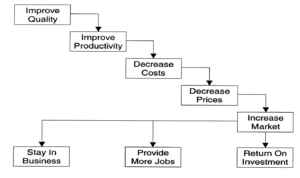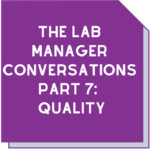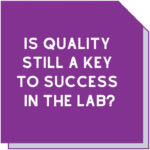Process improvements for productivity
written by Maree Stuart
 Since accredited or certified labs have solid systems in place, you could be forgiven for thinking there’s nothing much else that needs to be done.
Since accredited or certified labs have solid systems in place, you could be forgiven for thinking there’s nothing much else that needs to be done.
After all, your existing business processes are tried and true and mean that you can navigate those accreditation or certification visits relatively unscathed.
But (there’s always a but!) your accreditation and certification bodies will no doubt have mentioned improvement to you at some point. And since various ISO standards mention improvement as part of their requirements, we thought we’d look at process improvement in a little more detail.
What are process improvements?
As the name suggests, process improvements are about identifying, analysing, and improving your current business processes. By doing this you’ll be aiming to optimise performance for your customers and other end users.
Process improvements are essential for continual improvement in a lab’s quality management system. In fact, they help us realise one of the fundamental principles of quality espoused by Dr W. Edwards Deming in his 14 Points for Quality:
“Use statistical methods to find trouble spots and constantly improve the system”
There are different methods, techniques, and frameworks you can use to tackle process improvements. Each of these suits a different need and can include areas such as cultural changes and workflow mapping.
What are the benefits of process improvement?
As Dr Deming’s point suggests, process improvement gives you a path to spot and improve challenges in your processes. And that means you’ll be improving quality and productivity along the way.
These challenges could be damaging to the ability to achieve your “why” in business. Process improvement helps businesses realise goals and optimise customer experiences to assist with customer retention. Inefficient processes cost time and money.

So, taking care of those challenges by removing onerous approval processes or duplicate reporting makes good economic sense.
What methods can you use?
W. Edwards Deming’s Plan-Do-Check-Act (PDCA) cycle is possibly the most well-known. Breaking this down further, this cycle includes the following.
| Plan | 1. Select a problem and describe it clearly
2. Study the present system 3. Identify possible causes |
| Do | 4. Plan and implement a solution |
| Check | 5. Evaluate effects |
| Act | 6. Standardise any effective solutions
7. Reflect on process and develop future plans |
There are other approaches including Six Sigma, Lean, and Kaizen. All of the approaches involve the use of data to help support decisions on which processes to select for improvement and how to manage these challenges.
Of course, regardless of the approach used, we need data. That data can come from a host of quality assurance and management activities required by ISO management system standards. We’ve written previously on these aspects of a QMS. These include management review, internal and external audits, complaints, and non-conformances.
The key with all process improvement activities is to prioritise the areas to work on. What does the data tell you where your processes are letting you, and your customers, down? Our piece on 5 steps to risk management success is an excellent guide to help labs prioritise.
What are some areas you can investigate?
Onboarding of new staff
Hiring new people costs time and money. Investing in a speedy onboarding process makes sense from an economic perspective and for the morale of the new hire. Some points to consider:
- is there a plan in place for their first day/first week/first month?
- is there a structured process for them to follow to ensure compliance on the job?
- are you hiring several new people at once and if so, do you have the capacity to manage multiple hires?
- is there a way to manage the paperwork required more smoothly, perhaps through an online or automated system?
Keep in mind that other HR processes can all be automated, freeing up HR professionals from unnecessary paperwork. These include items such as expense forms, travel requests and payroll requests.
Cost savings
There are some items in a lab you simply can’t skimp on. But it’s also likely that there are places where savings can be made. For example:
- purchasing too much of an item with a short use-by date
- using the same supplier for years without checking if there’s a cheaper and more reliable supplier
- taking up valuable storage space with items that may only be used annually
Of course an excellent source of information about possible cost savings is your staff. They’ll know if you really need 12 boxes of an item or whether one will suffice.
Product or service quality
Quality is something that will be reflected across all your business practices. In addition, complaints or returns from customers and clients are important aspects providing feedback on your lab’s quality. So, do you have:
- a system for tracking complaints or reasons for product returns?
- control charts to determine the number of defects and to find common causes?
- a process to find the root cause of any issues?
We’ve written several helpful articles about root cause analysis. These have included asking why a business wouldn’t use it, how you can dig deeper and how to do root cause analysis properly.
In a lab, the tangible product is a lab report. The way information is presented is one aspect to think about when it comes to process improvement and ideas on this were in our article on Lab Report Writing 101. In our article about fraud we talked about the risks to labs from fraudulent reports. All of these are areas where process improvement should be investigated.
Automation can help
Eliminating manual work and reducing the possibility of human error can sound very appealing. In fact, robotic process automation (RPA) is big business and can help streamline some tasks or steps that don’t require human intervention. This could range from simple automated email responses to data transfer between systems. RPA can help create more efficiency and free up time for workers to complete more complex tasks.
That’s a lot to take in!
Many lab and quality managers feel overwhelmed at the prospect of process improvement. Firstly, where do you start? What does it even mean? How can you resource this? And how do you talk to the accreditation or certification body about it without making the lab look bad to the external auditors?
We are process improvement specialists, so it’s easy for us to talk about what it means and how to get it done. We’ve helped countless clients with process improvement. From improvements in turn-around time, through to improved waste management processes and everything in between, we’ve helped clients work better and smarter. In addition, we help labs understand what to say to the external auditors to showcase their process improvements in the best light.
If you’d like to discuss any of your Quality or process challenges, contact Maree (0411 540 709), Diane (0402 012 781) or email info@masmanagementsystems.com.au to set up a confidential discussion.
Remember, you don’t have to do this alone!
Download the article Process improvements for productivity





